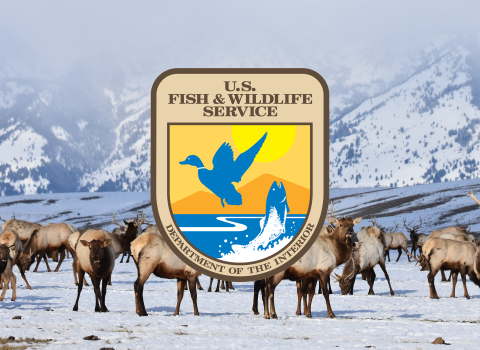WASHINGTON – President Donald Trump has proposed a $1.2 billion Fiscal Year 2019 (FY19) budget for the U.S. Fish and Wildlife Service, which includes proposed legislation to establish a Public Lands Infrastructure Fund that would take new revenue from federal energy leasing and development and provide up to $18 billion for repairs and improvements in national wildlife refuges, national parks and Bureau of Indian Education funded schools. The Service’s budget also includes $1.6 billion in permanent funding, which is administered to states through grants that support state wildlife and sport fish conservation, recreational boating and other related programs.
“President Trump is absolutely right to call for a robust infrastructure plan that rebuilds our national parks, refuges and Indian schools, and I look forward to helping him deliver on that historic mission," said U.S. Secretary of the Interior Ryan Zinke. “Our Parks and Refuges are being loved to death, but the real heart break is the condition of the schools in Indian Country. We can and must do better for these young scholars. This is not a republican or democrat issue, this is an American issue, and the President and I are ready to work with absolutely anyone in Congress who is willing to get the work done."
With these priorities in mind, the Service’s budget focuses funding on the nation’s highest priority conservation needs, access to existing federal lands for all Americans, and the agency’s role in streamlining energy development and infrastructure improvements, while containing costs through effective operations. Strategic investments support our core mission, while staying on top of National Wildlife Refuge System maintenance, and efforts to combat illegal trade in wildlife.
“The Service will use the coming fiscal year to maximize the efficiency of our programs for wildlife and our customers across the board,” said Greg Sheehan, the Service’s Principal Deputy Director. “As we continue to celebrate successes in the recovery of species, we look forward to welcoming more Americans to enjoy the bounty of our nation’s wild places.”
The FY19 budget includes the President’s continued focus on the following priorities:
Conserving our Land and Water:
Through the National Wildlife Refuge System, the Service continues the American tradition, started by President Theodore Roosevelt in 1903, of protecting fish and wildlife and their habitats and providing opportunities for hunting, fishing and other outdoor recreation to all Americans. The proposed FY19 funding level for the Refuge System is $473.1 million.
A total of $211.8 million is proposed to implement the Endangered Species Act and related programs, of which $80.8 million is dedicated to the recovery of threatened and endangered species including five-year species reviews and delistings and downlistings.
The Budget also acknowledges the significant threat that invasive species invasive species
An invasive species is any plant or animal that has spread or been introduced into a new area where they are, or could, cause harm to the environment, economy, or human, animal, or plant health. Their unwelcome presence can destroy ecosystems and cost millions of dollars.
Learn more about invasive species pose to native plants and wildlife, in addition to infrastructure. For example, species such as Asian carp, quagga and zebra mussels, and sea lamprey cost our economy billions of dollars annually through the damages they impose on economically valuable infrastructure and fisheries. The Administration proposes $14.3 million in funding for programs that focus on preventing the introduction and spread of aquatic, invasive species.
Expanding Outdoor Recreation and Access:
The FY19 budget request advances the implementation of Secretarial Order 3347, Conservation Stewardship and Outdoor Recreation, which calls for advancing conservation stewardship – through improving game and habitat management – and increasing outdoor recreation opportunities, particularly for hunters, anglers and sportsmen. In FY19, the Service will focus on opening additional acres of national wildlife refuges to new hunting and fishing opportunities and on aligning regulations with the states to better increase access and strike a regulatory balance.
In addition to maintaining its commitment to high quality fish and wildlife habitat and outdoor recreation, the Budget requests a total of $46.3 million to support sustainable management of waterfowl and other birds that are enjoyed by millions of hunters, photographers and wildlife enthusiasts each year, including $7.3 million for migratory bird monitoring and $3.2 million for the Service’s aviation program.
Modernizing our Organization and Infrastructure for the Next 100 Years:
Included in the request for the National Wildlife Refuge System is $135.5 million to invest in facilities and infrastructure managed by the Service. Of this, $41.0 million is to address the backlog in deferred maintenance.
In addition, $19.3 million is requested for maintenance of national fish hatcheries, which stock sport and subsistence fish for states and tribes and also propagate and release endangered aquatic species to aid in their recovery. An additional $50.0 million in funding is proposed for national fish hatchery operations.
Protecting our People and the Border:
Refuge law enforcement efforts support U.S. border protection wherever the border lies alongside or near national wildlife refuges. Refuge law enforcement officers provide assistance to and protection for refuge visitors, while working to prevent wildlife poaching and other activities that harm our refuge resources. A total of $38.0 million is proposed to fund these efforts.
The Service’s International Affairs program is funded at $14.5 million, and includes resources needed to combat wildlife trafficking. The Service’s work to eradicate illegal wildlife trade complements multi-agency law enforcement efforts to reduce associated international, organized crime. The program provides grants and technical assistance for the international conservation of endangered and threatened species.
Additionally, the Service’s Office of Law Enforcement, which contributes significantly to the multi-agency effort to combat wildlife trafficking and protects America’s wildlife from poaching, is funded at $69.5 million.
Generating Revenue and Utilizing our Natural Resources:
The budget includes $98.8 million to facilitate planning and consultation that will support energy and infrastructure development, which supports economic recovery and job creation in the United States. Timely evaluations of proposed infrastructure, energy, and other development projects contribute to job creation and economic growth. This funding will allow the Service to expedite project reviews and work with developers on appropriate mitigation and avoidance measures.
The President’s FY19 budget proposal for the Department of the Interior supports his commitment to create jobs, provide outdoor recreation through hunting and fishing, facilitate energy development and support law enforcement needs. The U.S. Fish and Wildlife Service Congressional Budget Justification is available here: https://www.fws.gov/budget/2019/FY2019%20FWS%20Budget%20Justification.pdf
The Department of the Interior oversees one-fifth of the nation's land and the entire Outer-Continental Shelf. The Department is charged with overseeing energy development on federal lands and waters, grazing allotments and timber sales, water conservation and delivery, upholding tribal trust responsibilities, conservation of wildlife and habitat, and maintaining access for recreation throughout public lands, among other priorities.


